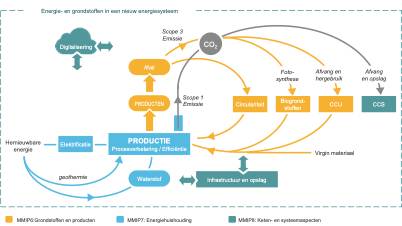The process industry is an important economic factor in the Dutch economy, and at the same time, a big user of energy and raw materials. More than a third of the total (final) energy usage is used in the industrial sector. More than 70 percent of which is heat. When we include the usage of energy carriers as raw material, we can even hold the industry accountable for 46 percent (ca 1100 PJ) of the total energy usage. This makes the industry responsible for more than 40 percent of national CO2-emissions.
In 2050, this will be different. The industry will be circular and hardly emit any greenhouse gas emissions. Factories and plants will work on sustainable energy electricity from solar and wind, or from geothermal energy, hydrogen and biogas. Raw materials will be extracted from biomass and residual flows and residual gasses. The residual heat will be used in the industry itself, or be supplied to horticulture, surrounding buildings and homes. The industry will not only remain an energy consumer, but become an energy producer and buffer as well. In 2030, the industry will have to have reduced its CO2 emission drastically. This will function as an intermediate step to complete sustainability.
The mission industry
Found above is the Mission Industry. Topsectors in the Netherlands have defines six Missions Energy transition and Sustainability. Government, entrepreneurs and knowledge institutions work together on these missions, by developing innovative solutions. For the industry, this comes down to:
Mission C: A climate neutral and circular industry in 2050.
The Mission Industry follows the agreements made in the Climate Agreement as well as in the Coalition Agreement. By 2050 the industry will be climate neutral, by switching to renewable energy sources, catching on to resting CO2-emissions and, if possible, realize negative emissions. Raw materials are sourced sustainably and re-used, so that the usage of raw materials will be limited to what is possible within plenary boundaries.
Innovating for a sustainable industry
Innovation is a necessity to realize these ambitions. Lots of the new production forms are still in their infancy - and are not yet ripe for the market. Companies invest in these renewals themselves. Grants and other instruments are needed to help growth and development. This way, the industry can grow to become the most Co2-effective industry in Europe - in a way that will not harm the international competitive position.
Topsector Energy supports the Mission Industry within three Innovative programs. These draw images of what innovation in a theme can contribute to the mission, and which innovational challenges may have to be faced in the short term. The three Innovation programs are:
- Innovation program 6: Raw materials and products for carbon circularity
- Innovation program 7: CO2-free industrial energy management
- Innovation program 8: Chain- and system aspects
These Innovation programs describe the innovations that are needed surrounding respective raw material usage, energy usage and the industrial system. Figure below shows how these themes cohere, and cover the mission of a climate neutral and circular industry together.

Work with us
Topsector Energy directly supports entrepreneurs and scientists with developing innovations that contribute to the Mission Industry, or one of the other missions. We stimulate forming consortia with innovational projects and bringing new products and technologies to the market. We do this by actively sharing our knowledge and using our network.
The different Topsectors each exist out of Top consortia for knowledge and innovation (TKI’s) The most important ones for the Mission Industry are:
● TKI Energy and Industry (Topsector Energy):
● TKI Biobased Economy (Topsector Energy):
● TKI Chemie (Topsector Chemistry):